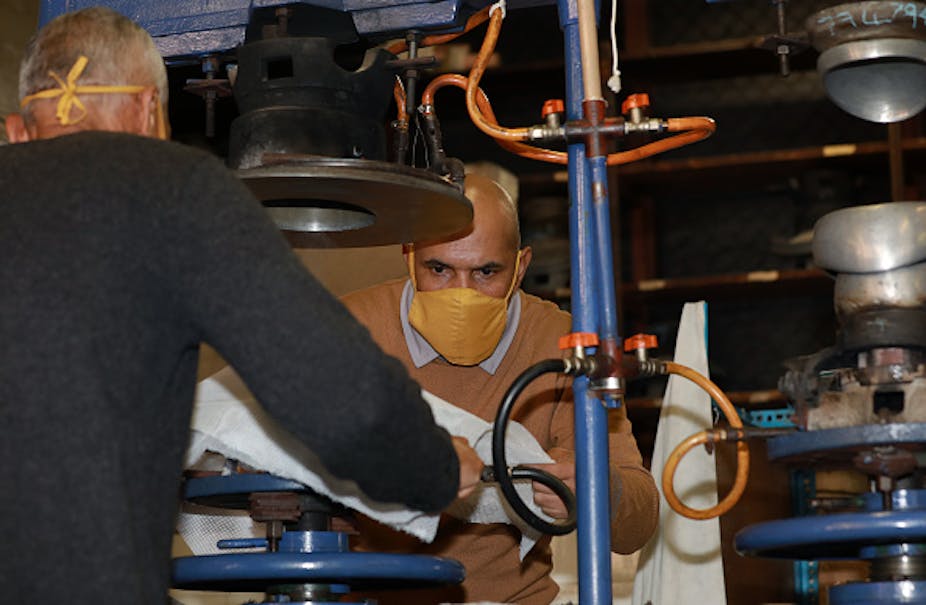In South Africa demands from business and trade unions to relax restrictions on the economy are growing. This comes even after President Cyril Ramaphosa said that most of the country may move to lower level restrictions before the end of May. Gauteng, the powerhouse of the economy, is likely to follow in June.
For those unable to work from home, being able to return to work is likely to come as a welcome relief. People unable to work because of lockdown restrictions are overwhelming concentrated in low-paid jobs. This includes jobs like domestic work and non-essential manufacturing.
But steps need to be taken before these workers can return.
The country’s occupational health and safety directive sets out what’s expected before a workplace can reopen. It must undertake a risk assessment and develop a written plan for how it will operate under the necessary health and safety restrictions. These measures must include appointing a COVID-19 compliance officer, ensuring social distancing in the workplace, screening and testing in workplaces with more than 500 workers. In addition, sanitisers, masks and other protective equipment must be provided.
Workplaces with over 500 workers must submit these plans to the Department of Employment and Labour and to their internal health and safety committee.
There are at least 1.8 million employers in South Africa. It would be impossible for the department to inspect every workplace to ensure its compliance with the occupational health and safety directive.
This system, therefore, relies on voluntary compliance by employers. But, sadly, high levels of noncompliance with basic labour laws are a common feature of the South African labour relations landscape. This is not peculiar to the conditions of lockdown but is indicative of a wider culture of noncompliance among employers in the country.
Culture of noncompliance and a lack of enforcement
Data from the labour department’s inspectorate shows that just over a third of the employers it has inspected since the beginning of the lockdown have not been compliant with occupational health and safety measures designed to protect workers.
Commenting on the high levels of noncompliance, the inspector general, Aggy Moiloa, said:
We are shocked that many organisations are still struggling to comply with the OHS Act. It should be every organisation’s habit.
But a quick look at the data for previous years shows that this level of noncompliance is normal and should not have come as a surprise.
Last year, the department reported to the employment and labour parliamentary portfolio committee that, on average, over a third (37%) of the employers inspected had not been compliant with the occupational health and safety act. Similar levels of noncompliance with basic labour law are also seen in the high percentage of employers that have failed to register their workers for the Unemployment Insurance Fund.
But the rate of noncompliance that the department has reported is likely to be just the tip of the iceberg as only a fraction of the inspectorate has been used under the lockdown.
As of November 2019, the department employed just under 1,800 inspectors. But the minister has stated that only 170, less than 10% of the inspectorate’s capacity, have been used for occupational health and safety inspections during lockdown. This may be because, ordinarily, inspectors have different competencies and not all inspectors may be trained in carrying out occupational health and safety inspections.
On 1 May 2020, the inspector general told the employment and labour parliamentary portfolio committee that a further 500 inspectors would be employed within a week. Even with an additional 500 inspectors, this would still only represent a third of the inspectorate’s total capacity.
Even if more inspectors are employed there is a need to increase the number of inspections carried out by each inspector. During the first 30 days of lockdown 2,226 inspections were conducted. This averages out to each inspector conducting 13 inspections over 30 days, about one inspection every two days. This rate of inspection seems particularly slow given that much of the economy was shut during this period.
Throughout this crisis, the labour department has called on employers to show “social solidarity” and to do the right thing by their workers. But this seems to have fallen on deaf ears. The labour minister has had to plead with employers to pay money to workers that they should have received from the Unemployment Insurance Fund COVID-19 Temporary Employer/Employee Relief Scheme. Indeed, the fact that employers seem unable to do the right thing by their employees has led the department to open up the scheme to allow workers to apply directly without having to wait for their employer to apply.
The department’s own inspections demonstrate that a significant section of employers are not voluntarily ensuring adequate health and safety precautions in the workplace.
The inspector general has said that its inspections are driven by reports from employees who must be the “first line of defence”. But, under the current conditions of economic uncertainty and retrenchments looming, many workers will be too fearful of losing their jobs to report their employers.
What needs to be done
The Department of Employment and Labour needs to take a stronger and proactive role in ensuring compliance through strong enforcement. It needs to use the full extent of the inspectorate’s capacity to ensure compliance with the necessary health and safety measures is enforced. Without this, any further reopening of the economy will put workers’ lives in jeopardy.

